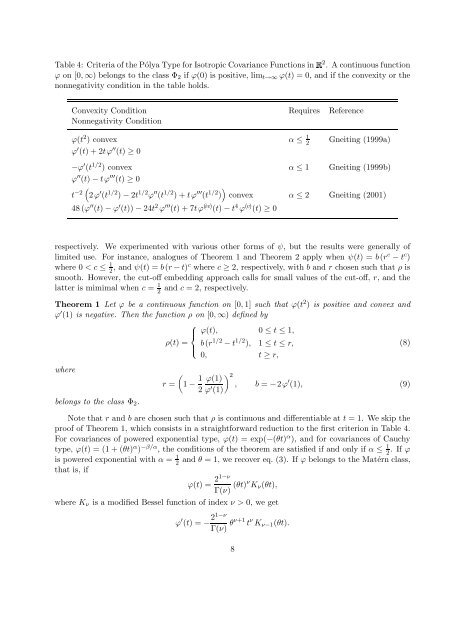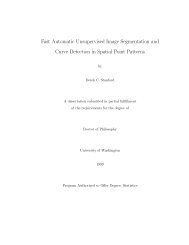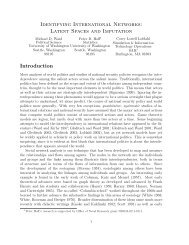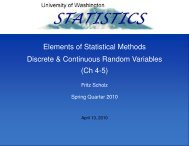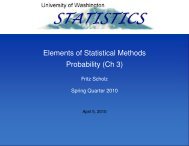Table 4: Criteria <strong>of</strong> the Pólya Type for Isotropic Covariance Functions <strong>in</strong> 2 . A cont<strong>in</strong>uous functionϕ on [0, ∞) belongs to the class Φ 2 if ϕ(0) is positive, lim t→∞ ϕ(t) = 0, <strong>and</strong> if the convexity or thenonnegativity condition <strong>in</strong> the table holds.Convexity Condition Requires ReferenceNonnegativity Conditionϕ(t 2 ) convex α ≤2 1 Gneit<strong>in</strong>g (1999a)ϕ ′ (t) + 2tϕ ′′ (t) ≥ 0−ϕ ′ (t 1/2 ) convex α ≤ 1 Gneit<strong>in</strong>g (1999b)ϕ ′′ (t) − tϕ ′′′ (t) ≥ 0( )t −2 2ϕ ′ (t 1/2 ) − 2t 1/2 ϕ ′′ (t 1/2 ) + tϕ ′′′ (t 1/2 ) convex α ≤ 2 Gneit<strong>in</strong>g (2001)48 (ϕ ′′ (t) − ϕ ′ (t)) − 24t 2 ϕ ′′′ (t) + 7tϕ (iv) (t) − t 4 ϕ (v) (t) ≥ 0respectively. We experimented with various other forms <strong>of</strong> ψ, but the results were generally <strong>of</strong>limited use. For <strong>in</strong>stance, analogues <strong>of</strong> Theorem 1 <strong>and</strong> Theorem 2 apply when ψ(t) = b(r c − t c )where 0 < c ≤ 1 2 , <strong>and</strong> ψ(t) = b(r − t)c where c ≥ 2, respectively, with b <strong>and</strong> r chosen such that ρ issmooth. However, the cut-<strong>of</strong>f embedd<strong>in</strong>g approach calls for small values <strong>of</strong> the cut-<strong>of</strong>f, r, <strong>and</strong> thelatter is mimimal when c = 1 2<strong>and</strong> c = 2, respectively.Theorem 1 Let ϕ be a cont<strong>in</strong>uous function on [0, 1] such that ϕ(t 2 ) is positive <strong>and</strong> convex <strong>and</strong>ϕ ′ (1) is negative. Then the function ρ on [0, ∞) def<strong>in</strong>ed by⎧⎪⎨ϕ(t), 0 ≤ t ≤ 1,ρ(t) = b(r⎪⎩1/2 − t 1/2 ), 1 ≤ t ≤ r,(8)0, t ≥ r,where(r = 1 − 1 )ϕ(1) 22 ϕ ′ , b = −2ϕ ′ (1), (9)(1)belongs to the class Φ 2 .Note that r <strong>and</strong> b are chosen such that ρ is cont<strong>in</strong>uous <strong>and</strong> differentiable at t = 1. We skip thepro<strong>of</strong> <strong>of</strong> Theorem 1, which consists <strong>in</strong> a straightforward reduction to the first criterion <strong>in</strong> Table 4.For covariances <strong>of</strong> powered exponential type, ϕ(t) = exp(−(θt) α ), <strong>and</strong> for covariances <strong>of</strong> Cauchytype, ϕ(t) = (1 + (θt) α ) −β/α , the conditions <strong>of</strong> the theorem are satisfied if <strong>and</strong> only if α ≤ 1 2 . If ϕis powered exponential with α =2 1 <strong>and</strong> θ = 1, we recover eq. (3). If ϕ belongs to the Matérn class,that is, ifϕ(t) = 21−νΓ(ν) (θt)ν K ν (θt),where K ν is a modified Bessel function <strong>of</strong> <strong>in</strong>dex ν > 0, we getϕ ′ (t) = − 21−νΓ(ν) θν+1 t ν K ν−1 (θt).8
It is not difficult to show that the conditions <strong>of</strong> Theorem 1 are violated if ν > 1 4. We believe but havenot been able to prove that they are satisfied if ν ≤ 1 4. Clearly, the conditions are sufficient only,<strong>and</strong> a function def<strong>in</strong>ed by (8) <strong>and</strong> (9) might belong to the class Φ 2 even though the assumptions<strong>of</strong> the theorem are violated.Theorem 2 Let ϕ be a cont<strong>in</strong>uous function on [0, 1] such that ϕ ′ (t 1/2 ) exists <strong>and</strong> is concave, ϕ(1)is positive, ϕ ′ (1) is negative, <strong>and</strong>2ϕ(1)ϕ ′′ (1) ≥ ( ϕ ′ (1) ) 2 .Then the function ρ on [0, ∞) def<strong>in</strong>ed by⎧⎪⎨ ϕ(t), 0 ≤ t ≤ 1,ρ(t) = b(r − t)⎪⎩2 , 1 ≤ t ≤ r,0, t ≥ r,(10)wherebelongs to the class Φ 2 .r = 1 − 2 ϕ(1) ( 1ϕ ′ (1) , b = ϕ ′ )(1) 2ϕ(1), (11)2 ϕ(1)This result is proved by a reduction to the second criterion <strong>of</strong> Pólya type <strong>in</strong> Table 4. If ϕ is apowered exponential or a Cauchy covariance, the conditions <strong>of</strong> Theorem 2 are satisfied if <strong>and</strong> onlyif α ≤ 1. If α ≤ 1 2both (8) <strong>and</strong> (10) yield valid covariances, <strong>and</strong> we prefer the function with thesmaller value <strong>of</strong> the cut-<strong>of</strong>f, r. For powered exponential covariances, for example, (10) has a smallercut-<strong>of</strong>f than (8) if 4αθ α > 1. If ϕ is a Matérn covariance, we conjecture that the assumptions <strong>of</strong> thetheorem hold if <strong>and</strong> only if ν ≤ 1 2. Aga<strong>in</strong>, the conditions are sufficient only, <strong>and</strong> a function def<strong>in</strong>edby (10) <strong>and</strong> (11) might well belong to the class Φ 2 even though the assumptions <strong>of</strong> Theorem 2 areviolated.When α > 1 for covariances <strong>of</strong> powered exponential <strong>and</strong> Cauchy type or ν >2 1 for Matérncovariances, the first two criteria <strong>in</strong> Table 4 do not apply, <strong>and</strong> our attempts to <strong>in</strong>voke the thirdcriterion have been <strong>of</strong> limited success. Partial results are available, but they are highly technical<strong>and</strong> depend on systems <strong>of</strong> equations that require numerical solution. Instead, we report numericalresults. Figures 1 <strong>and</strong> 2 illustrate the parameter ranges for which the block circulant matrixC(P r ρ, 2 · 2048, r/2048) is nonnegative def<strong>in</strong>ite, where ρ is def<strong>in</strong>ed by (10) <strong>and</strong> (11) <strong>and</strong> ϕ is <strong>of</strong> thepowered exponential <strong>and</strong> Matérn type, respectively. The associated numerical value <strong>of</strong> the cut-<strong>of</strong>fis illustrated, too. The results for Cauchy covariances with β = 1 or β = 2 are similar to those forthe powered exponential class.3.3 Intr<strong>in</strong>sic embedd<strong>in</strong>gThe <strong>in</strong>tr<strong>in</strong>sic embedd<strong>in</strong>g approach calls for elements <strong>of</strong> the class Φ 2 that are <strong>of</strong> the form (2), whereaga<strong>in</strong> ϕ is a st<strong>and</strong>ard covariance model. Follow<strong>in</strong>g Ste<strong>in</strong> (2002a), we consider⎧⎪⎨ a 0 + a 2 t 2 + ϕ(t), 0 ≤ t ≤ 1,σ r (t) = b(r − t) 3 /t, 1 ≤ t ≤ r,⎪⎩0, t ≥ r,(12)9


